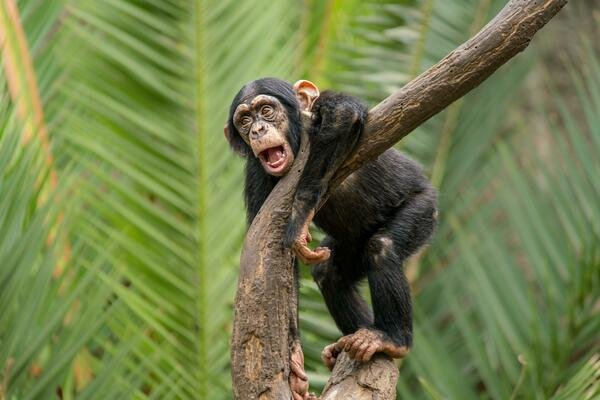
Chimpanzees are not just cute and intelligent; they’re also a keystone species. This means their presence is crucial for the survival of many other species in their habitat. They help with seed dispersal, control insect populations, and affect plant community dynamics. Understanding their role in the ecosystem is not just an academic exercise; it’s essential for conservation efforts and maintaining biodiversity. So, let’s dive into the many ways chimpanzees contribute to their environment.
Understanding Chimpanzees as Keystone Species
Chimpanzees are often referred to as keystone species, meaning their impact on their environment far exceeds their abundance. Imagine if you removed a few vital instruments from that orchestra; the music might become chaotic. Similarly, without chimpanzees, the ecosystem would struggle to maintain balance. Their activities—whether it’s foraging for food or building nests—profoundly influence other species and the environment around them.
For instance, when chimpanzees eat fruits, they don’t just consume them; they play a significant role in seed dispersal. Many plants depend on chimpanzees to carry their seeds away from the parent tree. Then, when chimps leave behind those seeds in their droppings, it creates an opportunity for new plants to grow, ensuring the continuation of those plant species. It’s a beautiful cycle that highlights their importance in preserving biodiversity.
The Role of Seed Dispersal
Seed dispersal might sound like a simple task, but it’s a critical component of forest health. As chimpanzees munch on fruits, they become roaming gardeners. They eat a variety of fruits, and their bodies are great at moving seeds. Here’s the thing: some plants have evolved to rely on chimpanzees for their reproduction. If chimps weren’t around, these plants would struggle to survive.
This phenomenon creates a rich habitat for other animals. For example, when seeds germinate in new areas, they provide food for various creatures—like insects, birds, and even other mammals. It’s a domino effect that begins with the chimpanzee. So, every bite they take contributes to a flourishing environment, making their role immensely valuable.
Impact on Plant Communities
Beyond seed dispersal, chimpanzees also influence the composition and structure of plant communities. When they choose which fruits to eat, they indirectly determine which plant species thrive in a given area. For instance, if chimpanzees prefer a particular fruit tree over others, that tree may become more abundant. This selective feeding can shape the landscape itself.
You might wonder how this affects other animals. Well, a diverse plant community supports a rich variety of herbivores and insects. More plants mean more food sources, which translates to a healthier ecosystem overall. In this way, chimpanzees are not merely participants in their environment; they actively shape it, ensuring that it remains vibrant and diverse.
Controlling Insect Populations
Chimpanzees do more than munch on fruits; they also have a knack for insect control. These clever primates often engage in behaviors that keep insect populations in check. For example, they may forage for termites and ants, leading to a reduction in those populations. It’s like they’re performing pest control while enjoying a tasty snack at the same time!
By controlling these insect populations, chimpanzees help maintain the balance in their habitat. Too many insects can lead to plant damage, which would negatively affect other species that depend on those plants for food or shelter. So, when you see a chimpanzee indulging in a termite feast, remember: they’re not just having a meal; they’re also playing a crucial role in the health of their ecosystem.
Social Structure and Community Dynamics
Chimpanzees live in complex social structures, which are fascinating to observe. Their interactions with each other—ranging from cooperative behaviors to conflicts—contribute to their ecosystem’s health. They engage in social grooming, which helps maintain bonds and reduces stress within the group.
The social dynamics of chimpanzees can also have ecological implications. When dominant males establish territories, they influence the movement of other animals in the area. This territorial behavior can lead to changes in which species are present in a given region, affecting biodiversity. In essence, the social interactions among chimpanzees echo through the forest, shaping not only their communities but also those of countless other creatures.
The Threats to Chimpanzees and Their Ecosystems
Despite their importance, chimpanzees face numerous threats that jeopardize their populations and, consequently, the ecosystems they help sustain. Habitat destruction from deforestation, hunting, and illegal wildlife trade puts immense pressure on their numbers. When their habitats are cut down for agriculture or urban development, the entire ecosystem feels the strain.
Moreover, the loss of chimpanzee populations can lead to cascading effects on forest dynamics. Without them, seed dispersal decreases, insect populations may explode, and plant communities become less diverse. This not only affects wildlife but also impacts human populations that depend on these forests for resources and ecological services. It’s a sobering thought, reminding us that protecting chimpanzees means protecting the health of entire ecosystems.
Conservation Efforts and Their Importance
The good news is that conservation efforts are underway to protect chimpanzees and their habitats. Organizations work tirelessly to establish protected areas, promote sustainable land use, and educate local communities about the importance of chimpanzees. These efforts are critical not just for saving a species, but for restoring and maintaining ecological balance.
Involving local communities in conservation is particularly effective. When people understand how chimpanzees benefit their environment and livelihoods, they’re more likely to protect them. Successful programs can create a sense of stewardship, ensuring that future generations will continue to appreciate and care for these incredible creatures and the ecosystems they inhabit.
In conclusion, the role of chimpanzees in their ecosystem is profound. They’re not just another animal; they’re integral to maintaining the health and balance of their habitats. By understanding their importance, we can better appreciate our responsibility to protect these remarkable creatures and the environments they support. It’s a partnership that benefits us all—humans and wildlife alike.
